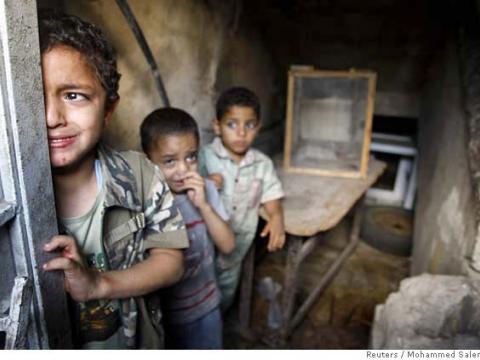Study reveals psychological toll of Middle East conflict on children

JERUSALEM-WESTBANK-GAZA - A recent study by the University of Michigan shows that children are being psychologically damaged by their exposure to the Palestinian-Israeli conflict.
This three-year study involved 1,500 Arab and Israeli youth and measured the psychological toll that the Israeli occupation and the Palestinian resistance has had on both Palestinian and Israeli children. Funded by the National Institute of Child Health and Development and the Fogarty Center for International Studies, the study was conducted by the University of Michigan Institute for Social Research (M-U ISR), the Hebrew University of Jerusalem, and the Palestinian Center for Policy and Survey Research in Ramallah.
The results show that Palestinian children in particular are seeing extraordinary amounts of very disturbing violence in their daily lives
“Like children everywhere, the children we work with on the Gaza Strip have a natural resiliency, only for Gazan children that resiliency is undermined by prolonged exposure to violence and the ominous threat of yet more violence, whether from around the corner or across the waves,” says Siobhan Kimmerle, World Vision Gaza Programme Director.
The study found that almost 50% of Palestinian children aged 11 to 14, have seen other Palestinians grieving over the injury or loss of a loved one as a result of Israeli attacks within the last year, and another 50% had seen other Palestinians injured or killed. Approximately 25% of Israeli children have seen other Israelis grieving and 10% have seen casualties.
Children that had witnessed the most violence exhibited high levels of anxiety, fear, nightmares, and debilitating thoughts. More than 70% of Israeli-Arab children have nightmares on a regular basis. “It (this exposure) is associated with dramatic increases in post-traumatic stress symptoms and increases in aggressive behaviour directed at peers,” says the Director of the Research Center for Group Dynamis at the M-U ISR and principal investigator of the project, Rowell Huesmann.
This violence has been found to cause a rolling effect, with children who were exposed to more violence at a significantly higher risk to be violent to other members of their own group. Just over half of the children exposed to the lowest levels of violence had committed one act of violence (such as slapping, punching, choking, threatening, etc) in the last year, in comparison to more than 71% of children exposed to the highest levels of violence.
Psychologist Ericx Dubow, a co-principal of the project, says, “The results show that Palestinian children in particular are seeing extraordinary amounts of very disturbing violence in their daily lives and the more they are exposed to violence, the more anxiety they experience and the more aggressively they behave.”
“We are called to care for the wellbeing of children and, together with communities in the north and the south of the Gaza Strip, we work to counter the effects of violence on children – we are contributing to an improved well-being for nearly 8,000 Gazan children”, added Kimmerle.
...the more they [children] are exposed to violence, the more anxiety they experience and the more aggressively they behave
World Vision is addressing the grave impact that the conflict is having on children’s wellbeing through group psychological counseling and support, workshops, and fun days for children. World Vision also conducts art therapy sessions and provides Child Friendly Spaces, where children can play and learn without the threat of violence.
Working with local partners and sector specialists, World Vision has developed a Life Skills Education curriculum which includes an innovative garden-based learning component and age-appropriate learning activities, that is at the core of a psychosocial support project piloted across 13 communities in Gaza for 500 children aged six to15.
World Vision continues to work for the wellbeing of children and advocate for an end to the Palestinian-Israeli conflict, which is leading to post-traumatic stress and aggressive behaviour.
This conflict threatens the lives of all children, and one of the greatest obstacles to achieving fullness of life for each and every child is the ongoing conflict and the perpetuation of violence. -Ends-